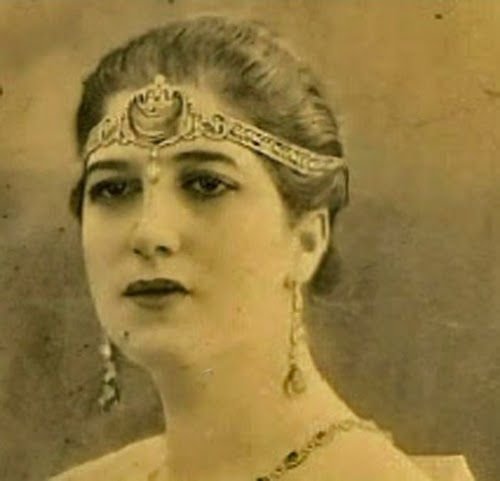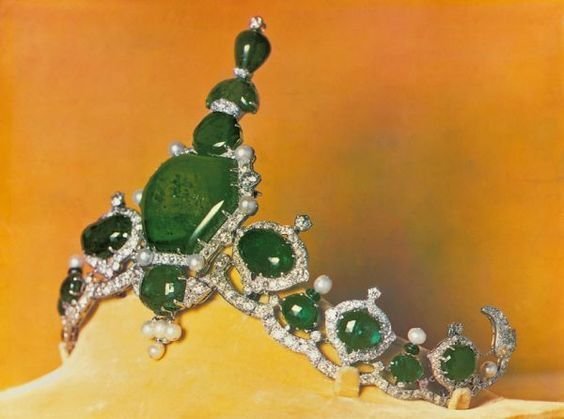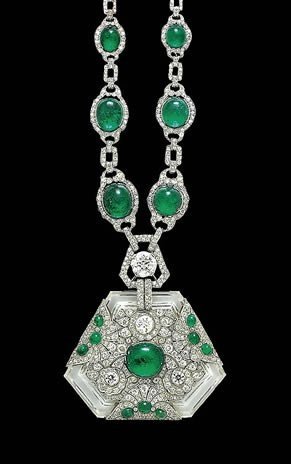THE JEWELS OF ANITA DELGADO, THE SPANISH MAHARANI
Anita Delgado, Prem Kaur, Maharani of Kapurhtala wearing her famous moon shaped emerald.
A long forgotten story was thrust into the spotlight again last year with the Victoria and Albert’s exhibition of Indian and Moghul jewellery in the Al Thani Collection. This was the romantic, true tale of Anita Delgado, the humble Spanish dancer raised to the rank of maharani and showered with jewels, some of which later found their way into the Al Thani Collection, most of which have been lost forever.
Anita Delgado was a beautiful flamenco dancer, born in Malaga, Spain, in 1890. Not much is known about her early childhood, other than her talent as a dancer and rudimentary upbringing. In 1906, at the tender age of 16 she was seen dancing in a cafe in Madrid by Sir Jagatjit Singh, Maharaja of Kapurthala, one of the great princely states of India. He was in Spain to attend the wedding of Alfonso XIII and Victoria Eugenia of Battenberg and he fell in love with Anita on sight. After much protracted courting during which Anita rebuffed all advances, she agreed to marry him. Spanish society was so appalled by this social mismatch that any signs of social climbing were met with derisory cries of ‘wanting to marry a maharaja’ for decades after.
Anita was carried off to Paris where she was given, in modern terms, a makeover. Not only was she taught how to eat, walk and talk but she was also showered in clothes and jewellery- and what jewels they were. It was the start of a lifelong passion, one that she shared with her husband. The jewels all reflect the changing tastes of the 20th century, starting with the naturalism of Art Nouveau, through the magnificent Belle Epoque and later, Art Deco. The 1920s saw a period of great collaboration between the Indian princely families and the great European jewellery houses. The maharajas had chests filled with ancestral stones, many of which were reset in bespoke creations in Europe in a style that successfully married the grand, Indian style with the clean, monochrome lines of Art Deco.
A peacock comb, one of the first gifts Anita received. The comb is by Mellerio, in a pure Art Nouveau style.
Anita married the Maharaja of Kapurthala in a civil ceremony in Paris and became the Maharani when she married him again in India under Sikh rites, taking the name of Prem Kaur. She was the maharaja’s fifth wife and it says a lot about her strength of character that she insisted on, and was given unheard of freedoms for a woman in India, being allowed to live in her own quarters outside the harem. One of the many gems she set her cap at was a magnificent, unusual emerald cut in the shape of a crescent moon which decorated a sacred elephant. Her husband granted it to her on condition that she learnt Urdu. She was proficient enough to have her request fulfilled six months later.
Sadly the marriage did not bring either of them happiness and the princely couple parted ways, divorcing in 1925. She was given a generous monthly stipend, allowed to keep all the jewels she had acquired during their marriage and allowed to keep her title, all on condition that she never remarried and never returned to India. Anita spent the rest of her life between Malaga, Biarritz, Deauville and Paris, dying in relative obscurity in 1962. A very considerable portion of her jewels and possessions were sunk in transport by shipping tank and the current maharaja’s family are still trying to recover them.
The Kapurthala Tiara in emeralds and diamonds, commissioned by the Maharaja in the early 1930’s and is a triumph of the neo Indian jewels Cartier was creating for Indian rulers at the time.
Rock crystal and emerald necklace presented by the Maharaja of Kapurthala to his wife Anita in 1925. Despite this, they divorced the same year.
Anita’s reward for learning Urdu.





